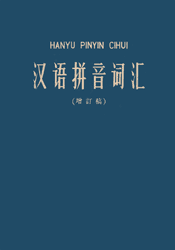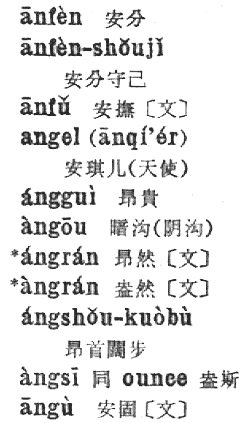 Today, for all you orthography junkies (Hello? Hello? Anybody there?), I have added a selection from the 1963 edition of Hanyu Pinyin Cihui (汉语拼音词汇 / Hànyǔ Pīnyīn Cíhuì).
Today, for all you orthography junkies (Hello? Hello? Anybody there?), I have added a selection from the 1963 edition of Hanyu Pinyin Cihui (汉语拼音词汇 / Hànyǔ Pīnyīn Cíhuì).
The book, which is fully alphabetized by Hanyu Pinyin (i.e., like the ABC dictionary series, not like the Hanzi-by-Hanzi Pinyin ordering seen in most dictionaries published in the PRC), is a long list of Mandarin words as written in Hanyu Pinyin and Chinese characters. It’s meant as a reference for word division and other such orthographic concerns. It’s the sort of thing that just cried out to have been made into a full dictionary (especially since that’s what it looks like, minus definitions); but, unfortunately, it never was. But it was an important influence on the ABC series.
One can see some interesting instances of differences between Pinyin orthography then and now. For example, in this old edition of Hanyu Pinyin Cihui de tends to be appended to words and written as d, e.g. ái’áid, rather than the current ái’ái de (皚皚的). Similarly, zi is written z at the end of a word, e.g. ǎigèz, rather than the current ǎigèzi (矮个子).
Also interesting is the mixed use of simplified and traditional Chinese characters. (It will be easier to see what I’m referring to if you open the PDF file of the introduction and A’s of Hanyu Pinyin Cihui.) The title on the cover is given as 汉语拼音词汇 in Chinese characters — perfectly standard. But below this is 增訂稿 (zēngdìng gǎo / revised edition); note how dìng is written as 訂 rather than as 订.
More striking, though, for the modern reader is the script in the foreword. Here, what was written 汉语拼音词汇 on the cover is written 汉語拼音詞汇, mixing traditional and simplified forms. The full traditional version of this would be written 漢語拼音詞彙. The text of the introduction is similarly mixed. This is because this was published before many simplified forms that are now standard were fully accepted officially.
The selection from this book here on Pinyin.info comprises the introduction and all of the entries beginning with the letter a.


I’m pretty sure the “mix” of simplified/traditional characters is a result of the stages of simplification; at this time in ’63, the ?radical and ? radical were consistently in the traditional form, and had not been modified along caoshu ?? lines yet.
A-gu is correct. This only looks like a mix from the modern perspective. The first round of simplifications was issued in 1956 by the Committee on Language Reform. It was called (????? Ji?nhuàzì Z?ngbi?o), and contained only 515 simplified characters. It wasn’t until 1964 that a revised edition of Ji?nhuàzì Z?ngbi?o was issued, with 2,238 simplified characters. This is the list used today.
Any official publication dating between 1956 and 1964 will appear today to be a mixture of traditional and simplified characters, but what you observe in this publication is simply what mainland simplified writing looked like in 1963.
> de tends to be appended to words and written as d, e.g. ái’áid,
> rather than the current ái’ái de (???). Similarly, zi is written z
> at the end of a word, e.g. ?igèz, rather than the current ?igèzi (???).
Too bad Mr. Yu Boquan didn’t just grab this older version and slap the
“Tongyong Pinyin” name on it, instead of wasting all his precious
brain power cooking up his own, just making the environmental clean-up
effort harder.
“This only looks like a mix from the modern perspective.”
Huh? Again: please compare the title of the book as it is written (1) on the cover of this book and (2) at the beginning of the fánlì of the very same volume.
1. 汉语拼音词汇
2. 汉語拼音詞汇
Note that the book has both 语 and 語, and both 词 and 詞. That’s a mix from the standpoint of any time.
Also, I’m doubtful that everything suddenly changed — especially not to uniformity — upon passage of the schemes, a belief that this sort of thing helps reinforce for me.
(Sorry for the extremely late response. This must have slipped my mind. But I’m about to mention this book in a new post and so looked this one up.)
Pinyin Vocabulary for reference:
http://en.wikibooks.org/wiki/Pinyin/Vocabulary
Pingback: Pinyin News » Pinyin sort order